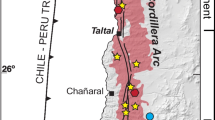Abstract.
Alkaline-related epithermal vein, breccia, disseminated, skarn, and porphyry gold deposits form a belt in the southern Rocky Mountains along the eastern edge of the North American Cordillera. Alkaline igneous rocks and associated hydrothermal deposits formed at two times. The first was during the Laramide orogeny (about 70–40 Ma), with deposits restricted spatially to the Colorado mineral belt (CMB). Other alkaline igneous rocks and associated gold deposits formed later, during the transition from a compressional to an extensional regime (about 35–27 Ma). These younger rocks and associated deposits are more widespread, following the Rocky Mountain front southward, from Cripple Creek in Colorado through New Mexico. All of these deposits are on the eastern margin of the Cordillera, with voluminous calc-alkaline rocks to the west. The largest deposits in the belt include Cripple Creek and those in the CMB. The most important factor in the formation of all of the gold deposits was the near-surface emplacement of relatively oxidized volatile-rich alkaline magmas. Strontium and lead isotope compositions suggest that the source of the magmas was subduction-modified subcontinental lithosphere. However, Cripple Creek alkaline rocks and older Laramide alkaline rocks in the CMB that were emplaced through hydrously altered LREE-enriched rocks of the Colorado (Yavapai) province have 208Pb/204Pb ratios that suggest these magmas assimilated and mixed with significant amounts of lower crust. The anomalously hot, thick, and light crust beneath Colorado may have been a catalyst for large-scale transfer of volatiles and crustal melting. Increased dissolved H2O (and CO2, F, Cl) of these magmas may have resulted in more productive gold deposits due to more efficient magmatic-hydrothermal systems. High volatile contents may also have promoted Te and V enrichment, explaining the presence of fluorite, roscoelite (vanadium-rich mica) and tellurides in the CMB deposits and Cripple Creek as opposed to deposits to the south. Deep-seated structures of regional extent that formed during the Proterozoic allowed the magmas to rise to shallow crustal levels. Proterozoic sites of intrusions at 1.65, 1.4, and 1.1 Ga were also important precursors to alkaline-related gold deposits. Many of the larger gold deposits are located at sites of Proterozoic intrusions, and are localized at the intersection of northeast-trending ductile shear zones formed during Mesoproterozoic deformation, and an important north-trending fault formed during 1.1 Ga rifting.
Similar content being viewed by others
Author information
Authors and Affiliations
Additional information
Electronic Publication
Rights and permissions
About this article
Cite this article
Kelley, K.D., Ludington, S. Cripple Creek and other alkaline-related gold deposits in the southern Rocky Mountains, USA: influence of regional tectonics. Min Dep 37, 38–60 (2002). https://doi.org/10.1007/s00126-001-0229-4
Received:
Accepted:
Issue Date:
DOI: https://doi.org/10.1007/s00126-001-0229-4




